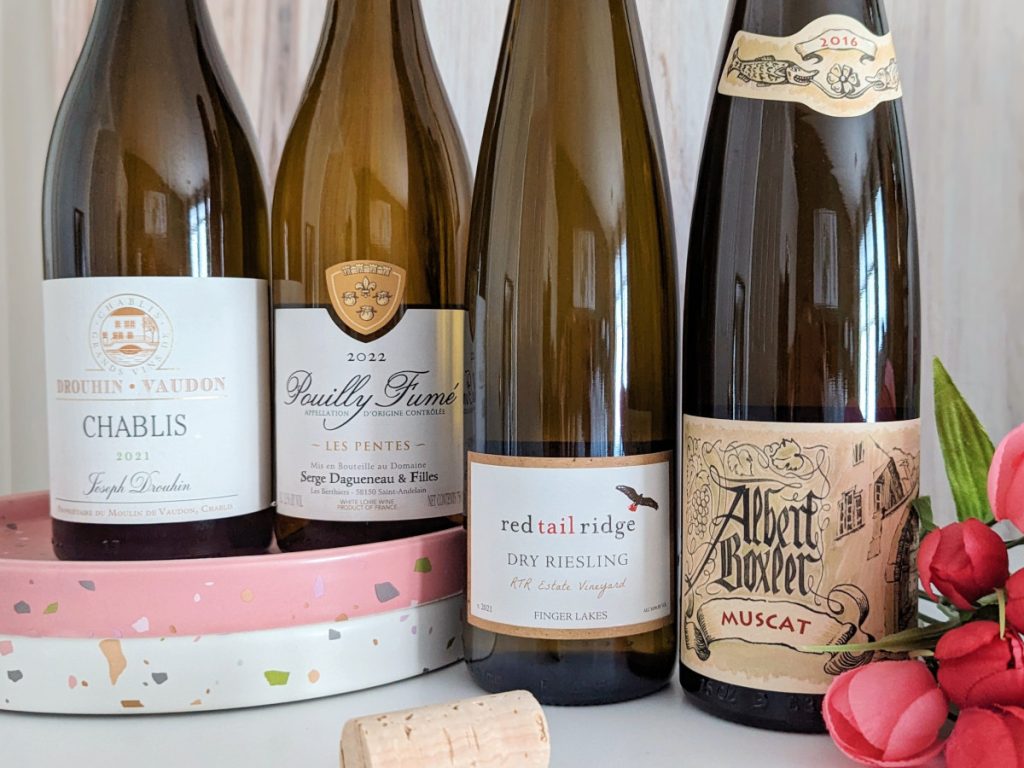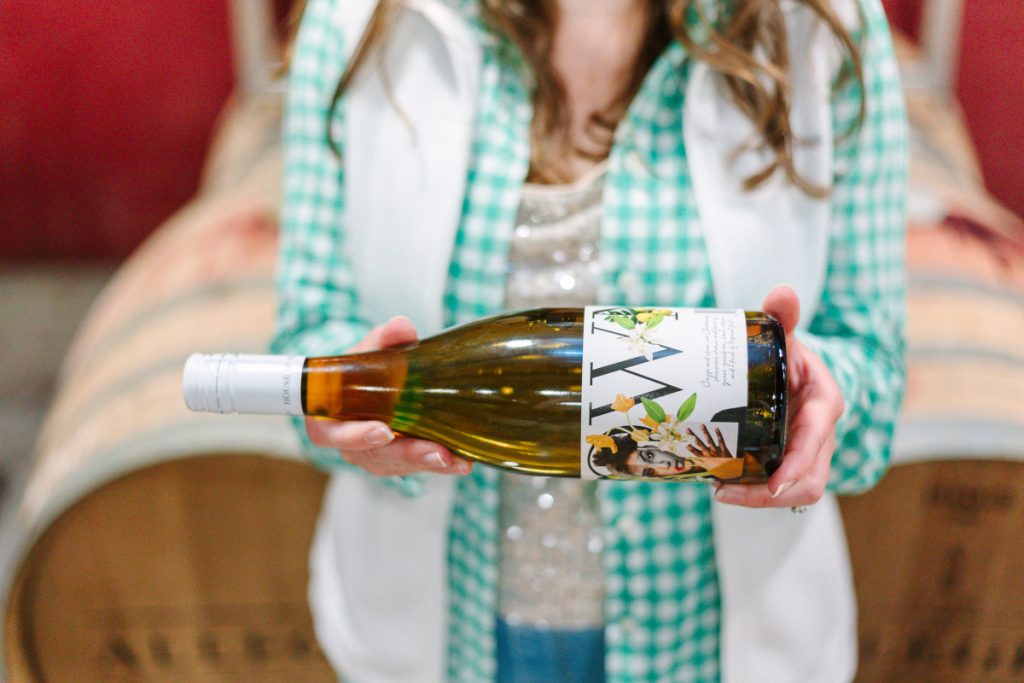
Photo by: Denise M. Gardner
Do you know your favorite white wine grape variety?
Or are you a California Chardonnay drinker, tried and true, that finds it difficult to branch out from your favorite style of wine?
Just like we learned with “The Classics: Red Wines”, you can also easily identify your favorite white wines, too. Identifying your wine preferences make it easier to navigate wine stores and provide you with greater confidence picking new wines that you will likely enjoy! (More tips on this in a future Sip & Swirl!)
Below, I’ve listed 5 wine grape varieties that fall into at least one of three “White Wine Taste Categories.” There are fewer Taste Categories of white wines in “The Classics”, compared to the red wines. The 5 Classics this month represent one of the 3 “White Wine Taste Categories” that I’ve coined as:
- Neutral Whites
- Oaky Whites
- Aromatic Whites
Just like red wines, yes, sometimes a wine grape variety can cross over into different categories. Second, each category often contains both “New World” and “Old World” examples. New World and Old World wine styles are like sub-groupings within the Taste Categories. Thus, there is a spectrum of flavor and mouthfeel profiles within each white wine Taste Category.
Nonetheless, determining which “Classic” (or “Classics”) you enjoy can help you identify which white wine Taste Category you prefer. Once you discover your white wine style preferences, I can lead you to your next wine selection that falls a little bit outside of the box! And don’t worry; We’ll cover this in a future Sip & Swirl!
Grape Variety or Grape Growing Region?
In the U.S., we tend to focus on wine grape varieties when it comes to wine. This can make it confusing when we try to find alternative wines from other countries like France, Italy, or Spain. In contrast to the U.S., these countries often label wines by the grape growing region in which the wine grapes were grown and produced into wine.
Thus, I’m going to help you find your preferences based on The White Classics. Once you identify the variety and style (New World vs. Old World, when available), I can help you search for additional wines outside of that comfort zone that you are likely to enjoy!
Need to review the difference between New World and Old World white wines? No problem! Check out this Sip & Swirl from April 2022: Do You Love Old World or New World Wines? The White Wine Edition.
Let’s take a look at a few of “The Classic” white wine grape varieties to help you discern what you like, and whether you favor Old or New World wine styles for a certain variety.
The Classics: White Wine Edition

Photos by: Denise M. Gardner

Photos by: Denise M. Gardner
Pinot Grigio / Pinot Gris (Wine Style: Neutral White)
Pinot Grigio and Pinot Gris (said “gree”) are the same wine grape variety. Internationally, Pinot Grigio tends to make a relatively neutral, refreshing, white wine. This is the type of white wine that simply tastes like white wine. The wines are relatively citrus-flavored (think fresh lemon and lime), with nuanced hints of florals like honeysuckle or fresh white fruits like apple and pear. Sometimes, in riper regions, peach flavors may creep their way into the aroma and flavor, but it is typically subtle. For the most part, many Pinot Grigio / Pinot Gris wines are dry and lack sweetness. But sometimes, you can find a good Alsatian (Alsace, France) Pinot Gris that is sweetened. For this variety, often the biggest difference between New World and Old World styles is acidity: New World Pinot Grigio tends to be less acidic (less sour) than Old World counterparts.
New World Style Pinot Grigio / Pinot Gris
- King Estate Pinot Gris
- Pinnacle Ridge Pinot Grigio (Pennsylvania)
- Brancott Estate Flight Song Pinot Grigio (New Zealand; Low Alcohol)
Old World Style Pinot Grigio / Pinot Gris:
- Eisacktal Valle Isarco Pinot Grigio (Alto Aldige, Italy)

Photo by: Savannah Smith Photography
Chardonnay (Wine Style: Neutral White)
I’ve split Chardonnay into two different styles of wine: Neutral White and Oaky White. As a Neutral White, Chardonnay is vibrant and has more intense nuanced flavors compared to Pinot Grigio / Pinot Gris. Chardonnay, as a variety often has a fresh apple, white blossom (floral), and even pineapple flavors that are more obvious compared to Pinot Grigio / Pinot Gris. Interestingly enough, too, Chardonnay is one of the few white wine grape varieties that can be used successfully as an oaky white wine (see the next category).
Finding a New World or Old World preference for unoaked/steel/naked Chardonnay is easier without the oak influence. One of the Old World styles I’m listing here, Chablis (said “shah-blee”), is not technically without oak. However, unlike the American style of oaky Chardonnay, Chablis often lacks oak flavor intensity. In terms of preferences, I find that many people that enjoy an unoaked Chardonnay also enjoy a refreshing Chablis. However, it tends to be more difficult to turn an Oaky Chardonnay drinker into someone that enjoys Chablis.
New World Style Chardonnay (Neutral):
- House of Brown Chardonnay
- Allegro Steel Chardonnay (Pennsylvania)
- Vasse Felix Filius Chardonnay (Margaret River, Australia)
Old World Style Chardonnay:
- Joseph Drouhin Bourgogne Chardonnay (France)
- Domaine Drouhin Vaudon Chablis (France)
- Louis Latour Pouilly Fusse (France)
Oaked Chardonnay (Wine Style: Oaky White)
Oaked Chardonnay is limited in terms of where it is produced and how it tastes. Chardonnay, as a wine grape variety, has the benefit of versatility for making multiple styles of wine. But for wine drinkers, especially those that love oaky Chardonnay, finding a Chardonnay without oak flavors can be confusing at best and off-putting at worst.
Oaky, rich Chardonnays were an American creation, benefiting from the “fruit forward” nature that many California wines became known for, and for use of American oak barrels, which often attribute some of the beloved oak Chardonnay flavors. In the American market, wine lovers that enjoy an oaked Chardonnay often appreciate the obvious flavors of butterscotch, vanilla, and fresh apple. The wines tend to lack sourness compared to a Chablis (which I listed in the Neutral White category), which make them quite easy to sip on by themselves. Oaked Chardonnays range from intensely oaky with rich butterscotch and vanilla flavors to lightly oaked in which a wine drinker may find it difficult to tease apart the nuanced flavors. Furthermore, Oaked Chardonnay from the Eastern U.S. tends to be more acidic than the Western U.S. counterparts. For those that love a good ol’ Chardonnay from California, rich in oak flavor, the Eastern style can be difficult to swallow. Nonetheless, because most of this style of wines is committed to New World winemaking regions, there are no direct Old World comparisons (well, except Chablis, but now it starts to get weedy). Thus, for comparison sake, I listed “Old World” wines from the Eastern U.S., which capture the acidity of Old World regions, but that oak the Chardonnay to the degree of California and other New World regions.
New World Style Oaked Chardonnay:
- Cambria Chardonnay, Katherine’s Vineyard
- Raeburn Chardonnay, Russian River Valley
- Willamette Valley Vineyards Chardonnay, Dijon Clone (Oregon)
- Gary Farrell Winery Chardonnay, Russian River Valley
- Nickel & Nickel Chardonnay, Napa, Truchard Vineyard
“Old World Style” Oaked Chardonnay:
- Veritas Reserve Chardonnay (Virginia)
- Penns Woods Chardonnay Reserve (Pennsylvania)
- Stokelan Crossroads (New Jersey)
Sauvignon Blanc (Wine Style: Aromatic White)

Photo by: Savannah Smith Photography
Historically one of the primary white wine grape varieties of Bordeaux, the devotion to Sauvignon Blanc can be fierce. In the more recent past, Sauvignon Blanc became a fan favorite with the introduction of New Zealand Sauvignon Blanc. Here, the wines are made in a very specific fashion which exacerbates the tropical aromatics of Sauvignon Blanc: gooseberry, papaya, mango, grapefruit, freshly cut green grass, passion fruit, and green apple. Sauvignon Blanc can taste like a literal fruit basket (well, minus the basket!) in one sip. But other regions, especially Old World regions, make Sauvignon Blanc in a more refrained style. These types of wines often have many of the tropical fruit flavors associated with the variety, but they are subdued in intensity. They may also seem softer and supplemented with a refined vanilla, sweet cream, or citrus flavor.
New World Style Sauvignon Blanc:
Old World Style Sauvignon Blanc:
- Domaine Serge Dagueneau & Filles Pouilly Fumé (France)
- Domaine Paul Buisse Touraine (France)
- Chateau La Freynelle Blanc (Bordeaux, France)
- Chateau Langlet Sauvignon Blanc (Bordeaux, France)
Riesling (Wine Style: Aromatic White)

Photo by: Denise M. Gardner
Riesling is an aromatic wine masterpiece. The flavors of Riesling wines are quite elegant: peaches, pears, apricots, and apples coupled with a mature citrus element including lemon, lime, and orange fruits. The intensity of these flavors will vary based on where the fruit was grown and the level of maturity that the grapes can reach.
The other thing many people enjoy about Riesling is that many of these wines are sweet. While dry (not sweet) sweet Rieslings certainly exist, the range in sweetness for this wine variety is vast. If you are someone that has a sweetness preference, many Riesling wines contain the intensity of sweetness on the back label of the wine bottle. This is to help wine lovers pick a Riesling that aligns best with their sweet preferences.
New World Style Riesling:
- Red Tail Ridge Dry Riesling
- The Storm Cellar Estate Dry Riesling
- The Storm Cellar Colorado Dry Riesling
- Hermann J. Wiemer Riesling Late Harvest (Sweet)
Old World Style Riesling:
- Weingut Robert Weil Riesling Trocken (Off-Dry)
- Selbach Oster Zeltlinger Sonnenhr Riesling Kabinett (Off-Dry, Low Alcohol)

Photo by: Denise M. Gardner
Muscat / Moscato (Wine Style: Aromatic White)
The Muscats are a family of wine grape varieties that are planted throughout the world. There are primarily 4 muscat varieties that are used to produce wine, each with different colors associated with the grape skins and with varying flavor profiles (Robinson). The two Muscats people are most familiar with include Muscat Blanc à Petits Grains, which is primarily used to make Moscato d’Asti from Italy, and Muscat Ottonel, which is planted in cooler climate winemaking regions. However, some of the popular Barefoot Moscato’s (produced out of California) also use Muscat of Alexandria. Muscato of Alexandria grapes are also used for raisin production.
Moscato d’Asti, produced in Italy, is a guaranteed sweet wine, and often lower in alcohol (<12%) compared to many other table wines. Moscato d’Asti is also sparkling, containing captured carbon dioxide in the bottle.
Muscat wines are incredibly fruity, often exuding flavors reminiscent of fresh fruits including peaches, grapes, kiwi, and pears, citrus including lemons and oranges, ginger, and florals like honeysuckle, and orange blossom.
New World Style Muscat / Moscato:
Old World Style Muscat / Moscato:
- Albert Boxler Muscat (Alsace, France)
- Centorri Moscato (Italy)

